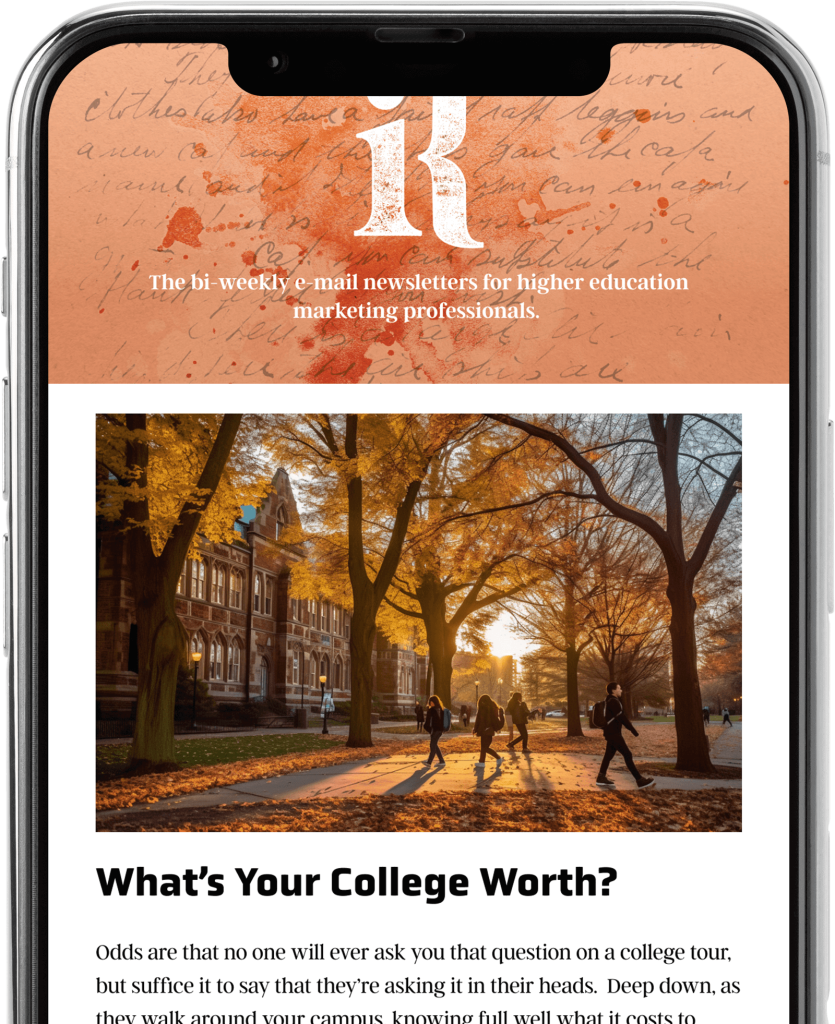Higher Education Marketing
Use Your Words

When I tell people about my work with higher education brands, the conversation often leads (assuming they are interested) to how we typically help the colleges and universities we serve. When I give them my answer—to someone not in the industry or perhaps a casual observer—they typically nod their heads in affirmation as if to say, “I can see why they might need help with that.” If it’s a person in the industry—a higher ed consultant, Chief Marketing Officer, or even a college President—they always nod their head in agreement with my response. One particularly distinguished higher education leader emphatically told me, “Ohhhh….We all need help with that!”
My answer? I tell them that we help colleges say something unique (and meaningful, of course) about themselves because so many are saying the same thing. From websites to billboards, collegiate marketing campaigns often sound the same. What do I mean by that?
So many of the ads I see for colleges and universities are saying roughly the same thing. More specifically, they’re using a lot of the same words to talk about themselves.
I recently grabbed a stack of Chronicle print editions to explore my theory. In about a dozen past issues, I tore out about 30 random ads, spread them out on the floor, and looked at the words. Spreading them out on the floor and taking a look, the common words almost jumped out at me. It reminded me of a stereogram—those 2-D images that become 3-D if you stare at them long enough.
Here are the words that I saw repeatedly jump out at me, which I’m guessing will be familiar to you. Colleges talked about:
– Innovation
– Impact
– Excellence
– Global
– Exceptional
– Top-Ranked
– Nationally Recognized
– Shaping
– Inspiring
– Transforming
– Creating
– Meeting
– Fostering
– Leading
– Climate Change
– Entrepreneurship
– Artificial Intelligence
– Sustainability
– Technology
– Leadership
These words came off the page in the ad copy because they were so often repeated in the copy, captions, and especially the headlines. A few of the headlines that echoed this theory were as follows:
– Committed to Excellence
– Leading with Innovation
– Leading the Way
– Shaping the Future
– Where History is Made
– Making History
– Meeting the Needs of Tomorrow
– Preparing Tomorrow’s Trailblazers
None of these words, phrases, or headlines are necessarily bad. Quite the opposite, candidly. This is why they are so often used and used again. The problem is that these concepts are interchangeable. If you took some of these ads and simply changed the logos, they would work with any competing institution. What college wouldn’t say that they are committed to excellence? No one would say that their university is satisfied with mediocrity. Of course, they are leading and making an impact. And most could point to a ranking or national recognition of some sort where they maintain pride.
Digging a bit deeper for validation, I did a high-level software scan, with some help from artificial intelligence, to extract some words from digital materials used by institutions. This is the result, which you will see repeated from my magazine experiment, sorted into some descriptive categories for further context:
Innovation and Excellence
– Innovative
– Excellence
– Cutting-edge
– State-of-the-art
– Leading
– Pioneering
Rankings and Prestige
– World-class
– Top-ranked
– Premier
– Prestigious
Community and Inclusion
– Community
– Diverse
– Inclusive
– Supportive
Opportunities and Engagement
– Opportunity
– Engage
– Transformative
– Comprehensive
– Personal Qualities
– Passionate
– Dynamic
– Driven
– Committed
Environment and Culture
– Vibrant
– Global
– Exceptional
So what is an institution to do with this realization? For starters, recognize that saying the same thing as everyone else is a recipe not for standing out but for blending in. We gravitate to these words, ironically, because they feel safe. Deviating from the pack with words carries more risk. But recall that “safe” is not necessarily “sound” when it comes to institutional messaging. In most cases, the two are polar opposites.
Following that, begin to find your words—not those that every other institution is using. Sound copy and campaign themes should not mimic or be interchangeable with those of competing or peer institutions. Your words should be your own, rooted in your institution’s values, its positioning, and overall point of view. Your words should help you stand out instead of blending in.
Like what you're reading?
Subscribe to our newsletter to get the latest insights in Higher Education and thought leadership.


